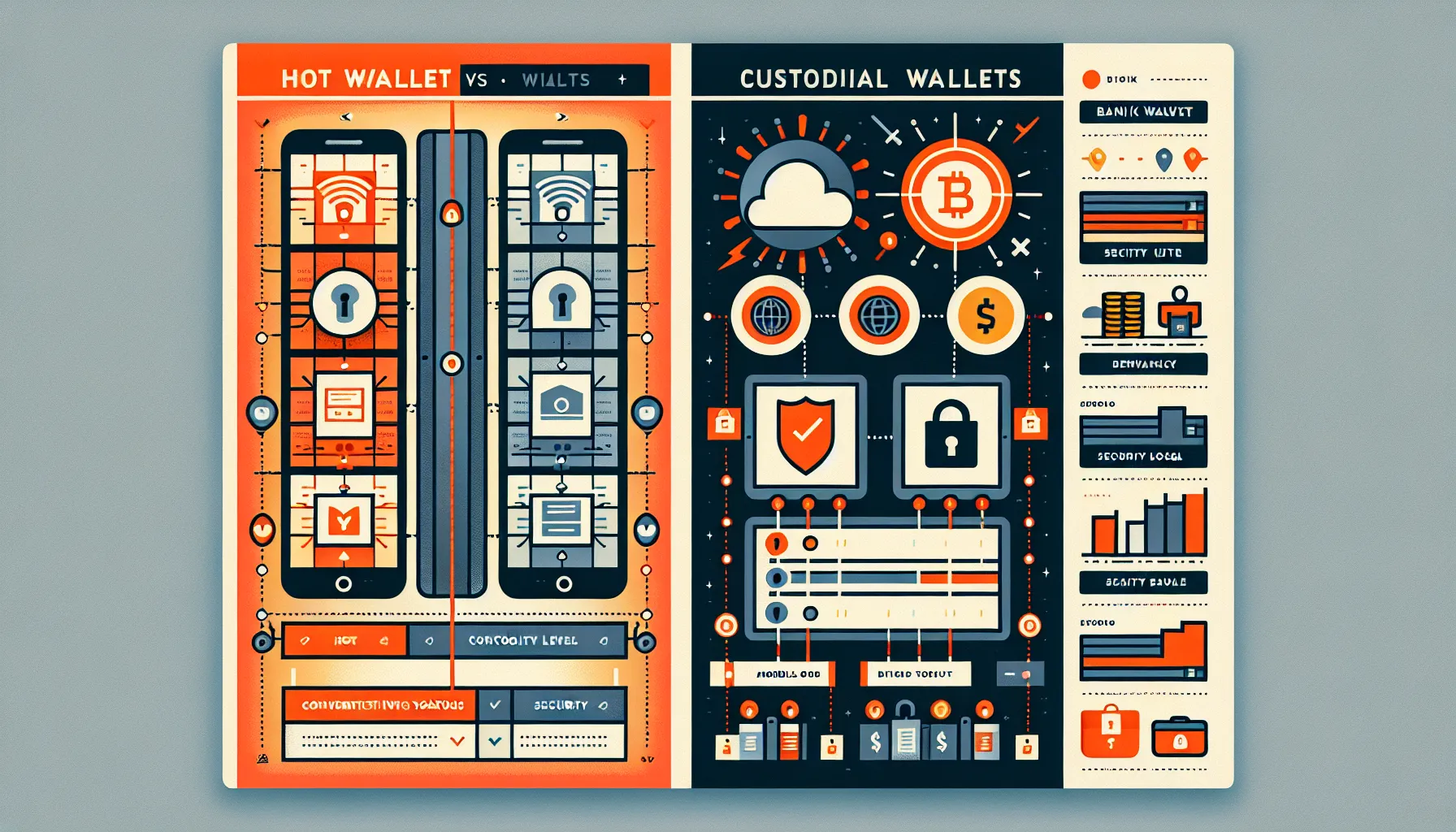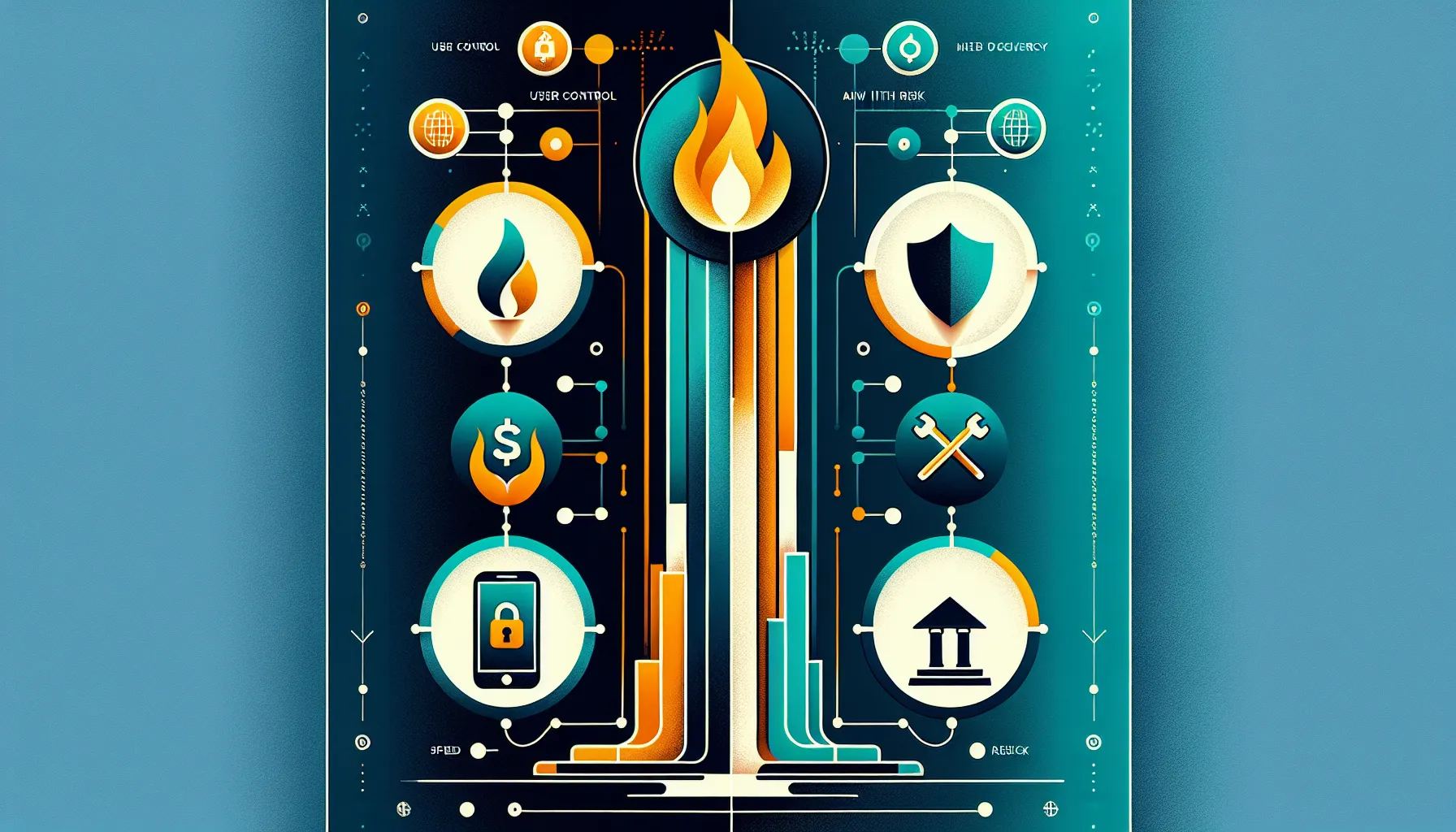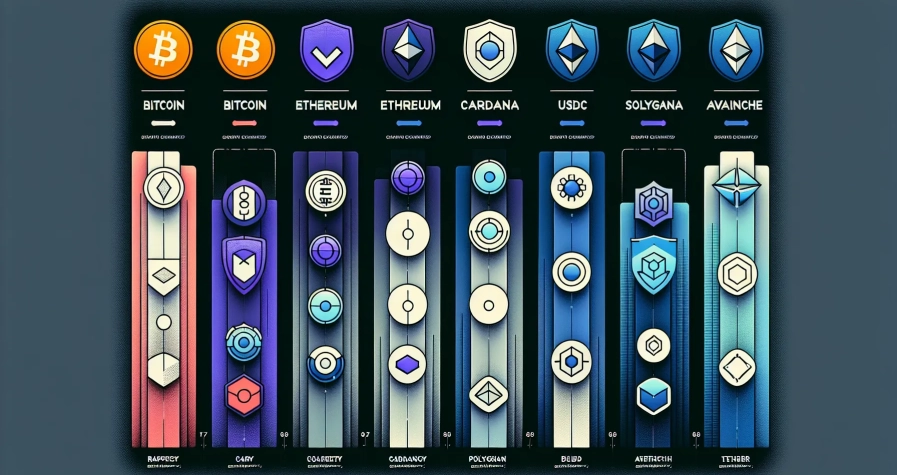Stepping into the world of cryptocurrency can feel like navigating a maze, especially when it comes to storing your digital assets safely. For newcomers, one of the first and most crucial decisions is choosing the right wallet, a digital tool that holds your private keys and grants access to your crypto. But with various options on the market, many beginners find themselves asking: should I use a hot wallet or a custodial wallet? And more importantly, which one keeps my funds safest?
Hot wallets stay connected to the internet, offering speed and convenience for everyday transactions. Custodial wallets, on the other hand, hand over control to a third party, typically an exchange or service provider, who manages your private keys on your behalf. Each comes with its own blend of security, ease, and autonomy. Understanding the differences is essential, because your choice could determine not just how easily you can send and receive crypto, but also how vulnerable your holdings are to hacks, loss, or mishaps. This article breaks down both wallet types, compares their security features, and helps new users decide which option truly suits their needs.
Key Takeaways
- Hot wallets stay online for quick transactions but carry higher hacking risks, whilst custodial wallets let third parties manage your private keys for easier account recovery.
- Custodial wallets are generally the safest starting point for new crypto users, offering beginner-friendly interfaces, password recovery, and customer support.
- Hot wallets grant full control over your funds but require users to securely manage their seed phrases, with no recovery options if lost.
- Choosing between hot vs custodial wallets depends on whether you prioritise convenience and support or autonomy and self-custody of your crypto.
- Most beginners benefit from starting with a custodial wallet, then transitioning to hot or cold wallets as their technical confidence grows.
Understanding Crypto Wallet Types

Before diving into hot and custodial wallets specifically, it’s worth understanding what a crypto wallet actually does. Unlike a traditional wallet that holds physical cash, a crypto wallet doesn’t store your coins directly. Instead, it secures the private keys, cryptographic codes that prove ownership and allow you to sign transactions on the blockchain. Without these keys, you can’t access or move your funds.
The crypto wallet landscape is typically divided into four main categories: hot, cold, custodial, and non-custodial. Hot wallets are always connected to the internet, making them ideal for users who trade or transact frequently. Cold wallets, by contrast, remain offline and are considered the most secure option for long-term storage. Custodial wallets involve a third party managing your keys, whilst non-custodial wallets give you full control (and full responsibility). For new users, the real question often boils down to hot versus custodial, two approaches that sit at opposite ends of the convenience-security spectrum.
What Are Hot Wallets?
Hot wallets are software-based wallets that stay online, whether they’re accessed through a mobile app, desktop programme, or web browser. Because they’re connected to the internet at all times, hot wallets allow for instant transactions, you can send, receive, or spend cryptocurrency within seconds. Popular examples include apps like Exodus, Trust Wallet, and MetaMask, as well as wallets built into exchanges.
The main appeal of hot wallets is their convenience. They’re fast, user-friendly, and perfect for anyone who needs to make regular transactions or check their balance on the go. Many hot wallets are also non-custodial, meaning the user holds their own private keys and maintains full control over their assets.
But, that constant internet connection is also the Achilles’ heel. Hot wallets are more vulnerable to online threats like hacking, phishing attacks, and malware. If a user’s device is compromised or they accidentally share their private key, funds can be drained quickly and often irretrievably. For this reason, hot wallets are generally recommended only for smaller amounts or funds you plan to use actively, rather than for long-term savings.
What Are Custodial Wallets?
Custodial wallets operate on a fundamentally different model. With these wallets, a third party, usually a cryptocurrency exchange like Coinbase, Binance, or Kraken, holds and manages your private keys on your behalf. You access your account using a username and password, much like a traditional bank account, but you never directly handle the private keys yourself.
The big advantage here is simplicity. New users don’t need to worry about securely storing seed phrases, managing backups, or understanding the technical intricacies of key management. If you forget your password, most custodial providers offer account recovery options, customer support, and even insurance in some cases. This makes custodial wallets incredibly beginner-friendly and less intimidating for those just getting started.
The trade-off, though, is control. When a third party holds your keys, you’re trusting them with your funds. If the exchange is hacked, goes bankrupt, or freezes your account, you could lose access to your cryptocurrency. There’s also the philosophical issue: one of crypto’s core principles is self-sovereignty, which custodial wallets inherently compromise. Still, for many newcomers prioritising ease and support over absolute autonomy, custodial wallets remain the most practical entry point into the crypto space.
Security Comparison: Hot vs Custodial Wallets
When it comes to security, both hot and custodial wallets present distinct risks and advantages. Neither is inherently “safe” or “unsafe”, the reality depends on how they’re used, the user’s level of technical knowledge, and the trustworthiness of any third parties involved.
Hot wallets place the burden of security squarely on the user. Since the wallet is always online and the private keys are stored on an internet-connected device, the risk of hacking or phishing is significantly higher. If a user downloads a malicious app, falls for a phishing scam, or fails to properly secure their device, their funds are at serious risk. But, for users who take proper precautions, enabling two-factor authentication, using strong passwords, and only storing small amounts, hot wallets can be reasonably secure for everyday use.
Custodial wallets, on the other hand, shift the security responsibility to the service provider. Users don’t have to worry about managing private keys or protecting seed phrases, which reduces the risk of personal error. Yet this introduces a different vulnerability: the provider itself. History is littered with examples of exchanges being hacked or collapsing, taking millions of pounds worth of user funds with them. The infamous Mt. Gox collapse in 2014 and more recent incidents with platforms like FTX highlight the real risks of trusting a third party.
In essence, hot wallets are vulnerable to individual mistakes and online threats, whilst custodial wallets are vulnerable to provider failures and large-scale breaches. The choice often comes down to whether a user feels more comfortable managing their own security or trusting an established company to do it for them.
Vulnerability to Hacks and Breaches
Hot wallets are prime targets for cybercriminals. Because they’re online, hackers can attempt to exploit software vulnerabilities, deploy malware, or trick users into revealing their private keys through phishing emails or fake websites. Even reputable hot wallet apps aren’t immune, if the user’s phone or computer is compromised, so is the wallet.
Custodial wallets face a different kind of threat. Whilst individual users aren’t usually targeted, the exchanges or platforms that hold millions in customer funds certainly are. A single successful breach can result in massive losses across thousands of accounts. Though many reputable exchanges invest heavily in security measures, cold storage, encryption, regular audits, no system is foolproof. And when a custodial provider is hacked, users are often left hoping for reimbursement or compensation, with no guarantee they’ll recover their funds.
Both wallet types demand vigilance. Hot wallet users must secure their devices and be sceptical of suspicious links or apps. Custodial wallet users should research providers carefully, ensuring they have strong security protocols, insurance policies, and a solid reputation.
Control Over Private Keys
Control is perhaps the single biggest differentiator between hot and custodial wallets. With a hot wallet (assuming it’s non-custodial), the user holds the private keys. This means full ownership and autonomy, no one can freeze your account, restrict your withdrawals, or demand documentation before you access your funds. You are the sole custodian of your crypto, which aligns with the decentralised ethos of blockchain technology.
Custodial wallets turn that model on its head. The service provider controls the private keys, and you access your crypto through their platform. This might sound risky, and it can be, but it also means the provider can help if something goes wrong. Forgot your password? They can reset it. Lost your phone? You can log in from another device. With a hot wallet, if you lose your seed phrase or private key, your funds are gone forever.
For experienced users who value independence, non-custodial hot wallets are ideal. For beginners who might struggle with key management, the safety net of a custodial wallet can be reassuring, even if it means sacrificing some control.
Ease of Use for Beginners
Let’s be honest: crypto can be intimidating. The terminology alone, seed phrases, private keys, gas fees, is enough to make many newcomers second-guess whether they’re ready to jump in. That’s where ease of use becomes a deciding factor, especially for those just starting out.
Custodial wallets win hands down in this category. Setting up an account usually involves nothing more than an email address and password, much like signing up for any online service. From there, users can buy, sell, and store crypto without ever seeing a private key or worrying about wallet backups. Most custodial platforms also offer intuitive interfaces, customer support teams, and educational resources to help new users find their feet. If something goes wrong, say, you can’t remember your login details, there’s a straightforward recovery process.
Hot wallets, whilst still relatively user-friendly, require a bit more technical understanding. Users need to download an app or browser extension, create a wallet, and then securely record their seed phrase, a list of 12 to 24 words that serves as a backup. Lose that seed phrase, and there’s no customer service hotline to call. This responsibility can be daunting for beginners who aren’t yet comfortable with the idea of being their own bank.
That said, many modern hot wallets have improved their onboarding experience dramatically. Apps like Trust Wallet and Exodus offer clean interfaces, simple setup processes, and plenty of in-app guidance. But the underlying responsibility remains: with a hot wallet, the user must take ownership of their security and backup practices. For someone brand new to crypto, a custodial wallet offers a gentler learning curve and a more forgiving environment to make mistakes.
Recovery Options and Account Access
One of the most nerve-wracking aspects of using crypto wallets is the possibility of losing access to your funds. In traditional banking, you can reset a password, call a helpline, or visit a branch. In crypto, the rules are different, and much less forgiving if you’re using a non-custodial hot wallet.
With hot wallets, account recovery hinges entirely on the user’s ability to retain their seed phrase. This phrase is generated when the wallet is first created and is the only way to restore access if the app is deleted, the device is lost, or the wallet is otherwise inaccessible. If you lose your seed phrase, no amount of technical support can retrieve your funds. They’re simply gone. This makes proper backup practices absolutely critical, but it’s also a step many beginners overlook or misunderstand.
Custodial wallets, by contrast, offer a safety net. Because the service provider controls the private keys, account recovery works much like it does for other online accounts. Forgot your password? Request a reset via email. Locked out after too many failed attempts? Contact customer support. Some platforms even offer two-factor authentication recovery, identity verification, and phone-based support. For new users who might not yet have a secure system for storing seed phrases, this added layer of protection can be invaluable.
Of course, this convenience comes with a caveat. If the custodial provider itself experiences issues, technical failures, legal troubles, or insolvency, users may find their access restricted or their funds frozen. Still, for day-to-day usability and peace of mind, custodial wallets offer far more robust recovery options than their non-custodial counterparts.
Cost Considerations and Fees
Cost might not be the first thing on a new user’s mind when choosing a wallet, but it’s worth considering, especially if you plan to move funds regularly or hold crypto long-term.
Hot wallets are generally free to download and use. There are no subscription fees, no account maintenance charges, and no third-party service costs. Users only pay network transaction fees (often called gas fees) when sending or swapping crypto, and these fees go to the blockchain network itself, not the wallet provider. This makes hot wallets an economical choice for users who want to avoid unnecessary expenses.
Custodial wallets, particularly those operated by exchanges, can come with a range of fees. These might include trading fees when buying or selling crypto, withdrawal fees when moving funds off the platform, and occasionally deposit fees or spreads (the difference between buy and sell prices). Some exchanges also charge for certain services like faster withdrawals or premium account features. Whilst many custodial wallets are free to open and maintain, the costs can add up over time, especially for active traders.
That said, some custodial platforms offer competitive or even zero fees on certain transactions to attract new users. It’s always worth comparing fee structures before committing to a provider. For beginners holding small amounts or making occasional transactions, the convenience of a custodial wallet often outweighs the modest fees involved. For more cost-conscious users or those planning to transact frequently, a hot wallet may offer better value in the long run.
Which Wallet Should New Crypto Users Choose?
So, which wallet type should a newcomer choose? The honest answer is: it depends. Both hot and custodial wallets serve different needs, and the right choice hinges on the user’s priorities, whether that’s ease of use, security, control, or cost.
For most new users, custodial wallets are the safest and most practical starting point. They remove the complexity of key management, offer account recovery options, and provide customer support when things go wrong. This makes them ideal for anyone who’s still learning the ropes and doesn’t yet feel confident managing their own private keys. The trade-off is trust: you’re relying on the provider to keep your funds secure and accessible. But for beginners prioritising simplicity and a safety net, that’s often a worthwhile compromise.
Hot wallets, on the other hand, suit users who are willing to take on more responsibility in exchange for greater control. They’re perfect for those comfortable with digital security basics and who want to embrace the self-custodial nature of cryptocurrency. If you’re tech-savvy, security-conscious, and motivated to learn, a hot wallet offers autonomy and aligns more closely with crypto’s decentralised philosophy.
Eventually, many users end up using both. A custodial wallet might serve as a beginner-friendly entry point, whilst a hot wallet is used for smaller amounts or active trading. There’s no one-size-fits-all answer, just the option that best matches your comfort level and goals.
When to Use a Hot Wallet
Hot wallets shine in scenarios where convenience, speed, and control are paramount. They’re ideal for users who make frequent transactions, whether that’s trading, tipping, making purchases, or interacting with decentralised applications (dApps). Because hot wallets are always online, they allow instant access to funds without needing to log into a third-party platform.
They’re also suited to those who are comfortable with technology and willing to take security into their own hands. If you’re confident in your ability to secure your device, back up your seed phrase properly, and avoid phishing scams, a hot wallet offers unmatched autonomy. Just remember: only store amounts you’re prepared to use actively. For long-term holdings or large sums, a cold wallet or more secure solution is advisable.
When to Use a Custodial Wallet
Custodial wallets are the go-to choice for beginners, short-term holders, and anyone who values simplicity over sovereignty. If you’re new to crypto and still getting your bearings, a custodial wallet removes much of the technical burden and lets you focus on learning how the ecosystem works without fear of losing everything to a misplaced seed phrase.
They’re also ideal for users who want easy account recovery, customer support, and a familiar login experience. If you’re holding crypto temporarily, planning to trade on an exchange, or simply don’t want the stress of managing keys yourself, a custodial wallet is a sensible, low-friction option. Just be sure to choose a reputable provider with strong security measures and, ideally, some form of insurance or user protection.
Conclusion
Choosing between a hot wallet and a custodial wallet isn’t about finding the “perfect” option, it’s about finding the right fit for your experience level, risk tolerance, and how you plan to use your crypto. Hot wallets offer speed, independence, and control, but they demand more responsibility and technical know-how. Custodial wallets prioritise ease of use, account recovery, and beginner-friendly features, though they require you to trust a third party with your private keys.
For most new crypto users, custodial wallets represent the safest and most accessible starting point. They lower the barrier to entry, reduce the risk of user error, and provide a supportive environment for learning. As confidence grows and technical understanding deepens, many users naturally migrate towards hot wallets or even cold storage solutions for greater autonomy and security.
Whichever path you choose, the most important step is to get started, thoughtfully, securely, and with a clear understanding of what each wallet type offers. Crypto is a journey, and your wallet is simply the first tool in a much larger toolkit.
Frequently Asked Questions
What is the main difference between hot wallets and custodial wallets?
Hot wallets remain connected to the internet for instant transactions and allow users to control their private keys, whilst custodial wallets involve a third party managing your keys, offering simpler access through username and password like traditional banking.
Which wallet is safer for new crypto users: hot or custodial?
For most beginners, custodial wallets are safer as they remove the complexity of key management, offer account recovery options, and provide customer support. However, users must trust the provider with their funds and accept reduced autonomy.
Can I recover my cryptocurrency if I lose access to my hot wallet?
Recovery is only possible if you’ve securely stored your seed phrase—a list of 12 to 24 words generated when creating the wallet. Without this phrase, there’s no way to retrieve your funds, as no customer support can assist.
Are custodial wallets insured against hacks and exchange failures?
Some reputable custodial providers offer insurance or user protection schemes, but coverage varies significantly between platforms. It’s essential to research your chosen provider’s security measures, insurance policies, and track record before entrusting them with funds.
How do transaction fees compare between hot wallets and custodial wallets?
Hot wallets are generally free to use, with users only paying blockchain network fees. Custodial wallets may charge trading fees, withdrawal fees, and spreads, though many offer competitive rates to attract new users.
Should I use both a hot wallet and a custodial wallet?
Many experienced users employ both: a custodial wallet for ease of use and onboarding, and a hot wallet for active transactions requiring greater control. This hybrid approach balances convenience, security, and autonomy as your crypto knowledge develops.









